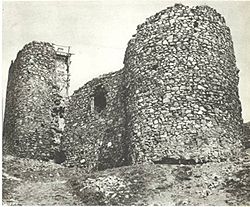Avala
It is situated in the south-eastern corner of the city and provides a great panoramic view of Belgrade, Vojvodina and Šumadija, as the surrounding area on all sides is mostly lowlands.
It is possible that in the future the entire area of Avala would create a separate municipality of Belgrade, named Avalski Venac.
Until 600,000 years ago, when the surrounding low areas were flooded by the inner Pannonian Sea, Avala was an island, just as the neighboring mountains (Kosmaj, Fruška Gora, etc.
The mountain is built of serpentinite, limestone and magmatic rocks, which are injected in the shape of cone (laccolith).
Optically examined by the Israeli mineralogist Tamir Grodek who classified it as a member of the mica mineral group.
[4] On the southern slopes, in the area of Ripanj, the closed Tešićev Majdan ("Tešić Quarry") is located.
The stone pit was privately owned, but was confiscated by the state after World War II and stopped operating before 1960.
Features built with this stone include the fountain between the Novi Dvor and Stari Dvor, the bordure of the Hotel Bristol, Small Staircase in Kalemegdan Park, pedestal of the Play of Black Horses statues in front of the House of the National Assembly of Serbia and buildings of Belgrade Cooperative, Elementary School King Petar I, Cathedral Church of St. Michael the Archangel and Main Post Office Building.
As the buildings began to deteriorate over time, city authorities showed interest in the quarry, not only for the repairs but also for future construction.
For now, when some deteriorated kersantite feature has to be replaced, the artificial stone is used (as in the case of the pedestal of the Play of Black Horses).
That year, Serbian ruling prince Miloš Obrenović issued an order for the Avala to get fenced and protected that way.
In his last visit to Serbia in 1903, Austro-Hungarian naturalist Felix Philipp Kanitz noted that the mountain would become "another exceptional excursion area", after the Topčider park.
That way, Avala entered a circle of protected green areas of Belgrade, which also included the mountain of Kosmaj, the island of Veliko Ratno Ostrvo and the woods of Stepin Lug, with the forests of Košutnjak and Topčider to be added next.
Some of them are protected by the law as natural rarities, like certain types of laburnum, box tree, black broom, common holly and martagon lily.
In 1442. it was conquered by the Ottoman Empire, which built a new town in Žrnov's place as a counter-fortress to the Belgrade city fort, and renamed it "havale", which originally comes from Arabic and means "obstacle" or "shelter".
Archeologist Miloje Vasić believed that the vast mines of cinnabarite (mercury-sulfide) on Avala were crucial for the development of the Vinča culture, on the banks of the Danube circa 5700 BC.
[1] Šuplja Stena ("Hollow Boulder") was a mercury mine while in Crveni Breg ("Red Hill"), lead, zinc, silver and gold were extracted.
By 2009 the upper level was prepared for visitors, having been cleaned and lighted for some 300 m (980 ft), but the project of turning it into a tourist attraction failed.
Smelters was built, the production continued in 1968 and until spring 1972 when it was finally closed, the mine produced 80 tons of mercury.
Germans halted their mechanized units along the Smederevo road, at Mali Mokri Lug, continued equipped with the light weapons and spread over Avala.
Germans also had a 7th SS division at the mountain, but after the joint attack of Yugoslav Partisans and Red Army, Belgrade was liberated on 20 October 1944.
[20] In 1965, a 202-metre-high (663 ft) Avala TV Tower was constructed, one of the tallest structures in the Balkans, by the architects Uglješa Bogunović, Slobodan Janjić and M. Krstić.
Belgrade's General Urbanistic Plan (GUP) for the 2001–2021 period defines the mountain as a sports and recreation area.
The idea was to split municipality of Voždovac of its distant, suburban settlements in the area of the Avala: Ripanj, Beli Potok, Pinosava and Zuce.
Avalski drum ("Avala road") is an extension of the Boulevard of the Liberation, which directly connects the mountain to downtown Belgrade (via neighborhoods of Selo Rakovica, Jajinci, Banjica, Voždovac, Autokomanda, Karađorđev Park and Slavija).
They include: Small church dedicated to the Saint Despot Stefan Lazarević was built in the immediate vicinity of the Avala Tower and Monument to the Unknown Hero.
Despite low altitude, construction of the ski resort, with sports and recreational venues and a cable car have been proposed in 1994 and 2005.
The construction of the complex, which is planned to be operational over the entire year thanks to the artificial snowing system (skiing specifically from November to February), should start in 2019.
[34][35] Phase I includes the construction of the piste, ski lift, training trail, snowmaking cannons, decorative lights, parking lots and special machinery.
Phase II comprises the building of the bobsled on rails track, zip-line, mini golf course, artificial climbing rock, children playground and an adventure park.





